:::::::::::::::::::::::::::::::::::::::::::::::::::::::::::::::::::::::::::::::::::::::::::::::::::::
Hat, Strawhat and more (kasa)
***** Location: Japan, worldwide
***** Season: Summer, others see below
***** Category: Humanity
*****************************
Explanation
笠 in Japanese is often translated as "straw hat", ... BUT
the English "straw hat" in Japanese is a "wara booshi " or even "mugiwara booshi".
Let us examine some kigo and words with our headgear.
xxxxxxxxxxxxxxxxxxxxxxxxxxxxx
straw hat, sedge hat, bamboo hat, umbrella-hat, kasa 笠
Read more about the translation of this word here.
sedge hat, sugegasa 菅笠
bamboo hat, ajirogasa 網代笠
straw hat, warabooshi 藁帽子
. Legends about Sugegasa .
:::::::::::::::::::::::::::::::::::::::::::::::::::::::::::::::::::::::::::::::::::::::::::::::::::::
Pilgrim's Hats
Pilgrimages have been very popuar during the Edo period, as a means to travel freely and get out of the town. There are various types of straw hats for the pilgrims, these words are all kigo for spring. The hat was also a protection against rain.
Read more about this kigo
WHC World Kigo Database: Pilgrimage (henro)
Shikoku Pilgrim's hat, henrogasa 遍路笠
for the pilgrimage in Shikoku henro gasa henro kasa
This example is woven from sturdy bamboo and has a diameter of 40 centimeters. The inscription reads: Dogyo ninin (doogyoo ninin 同行二人), two on the road. It signifies that Kobo Daishi is always walking with the pilgrim. Read my link given above about the details of a pilgrimage to the 88 temples of Shikoku. dogyo ninin

www.rakuten.co.jp/gintengai/415741/416913/575748/
made from sedge in a mountain form, sugegasa 菅笠 山型
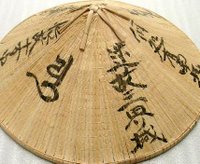
http://www.rakuten.co.jp/eitikai/552877/523671/523916/
There are six inscriptions for it:
菅傘には次の6つの言葉が書かれています。
「迷故十万空」・「迷故三界城」・「同行二人」・「何処有南北」・「本来無東西」・弘法大師を表す梵字が1字です。
made from sedge in the form of Mt. Fuji 菅笠 富士型
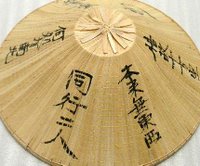
http://www.rakuten.co.jp/eitikai/552877/523671/523917/
made from pine bark, hinokigasa ひのき笠 hinoki gasa
This hat is rather large and protects the walking pilgrim from rain. In our modern times it comes with a plastic cover to protect the hat from the rain !
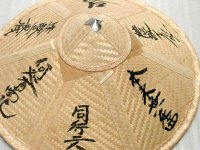
http://www.rakuten.co.jp/eitikai/552877/523671/523918/
made from finely woven bamboo, ajirogasa 網代笠 ajiro gasa ajiro-gasa
This hat is also worn by priests. This is a high-quality bamboo hat. It's diameter is 51 cm. (And it costs around 200 dollars.)
This type is also traditionally imregnatged with the sap of the persimmon tree (kakishibu) to make it rainproof. It becomes a dark orange/brown color.

http://www.rakuten.co.jp/eitikai/552877/523671/523920/
for the modern-day pilgrim, junpai booshi 巡拝帽子
White cotton cloth. Shikoku pilgrims wear all white cloths, to show their determination to finish the pilgrimage or die on the way. (White was the color of death cloths.)
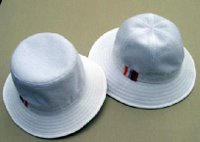
http://www.rakuten.co.jp/eitikai/552877/523671/577788/
... ... ... ... ...
minachigasa 皆地笠 minachi gasa
for the pilgrimage to Kumano
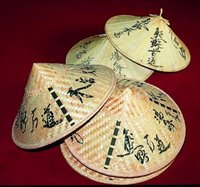
http://www.pref.wakayama.lg.jp/prefg/060300/kougei/kasa.html
... ... ... ... ...
for the pilgrimage to 33 Kannon Temples, junreigasa 巡礼笠
The Pilgrimage to 33 Kannon Temples
These hats are usually without inscription. Any of the above types without inscription can also be used.
pine bark hat, hinokigasa ひのき笠 junrei gasa

http://www.rakuten.co.jp/eitikai/552877/523671/576777/
External LINK to more staw hats
lordless warriour hat, rooningasa 浪人笠
komuso priest hat, tengai 天蓋
hat for begging, takuhatsugasa 托鉢笠
traveller's hat, sandoogasa 山道笠
hat for a woman travelling, tsumaoregasa 妻織笠
warriour's camp hat, jingasa 陣笠
travelling hat for female entertainers, okesagasa おけさ笠
http://www.shop-japan.co.jp/english-boku/warring5-s.htm
http://www.shop-japan.co.jp/shop/n-kaburikasa-s.htm
More Photos of : warriour's camp hat, jingasa 陣笠
More Photos of : komuso wandering monk hat, tengai 虚無僧の天蓋
More Photos of : hat for female entertainers, okesagasa おけさ笠
Look at Japanese Pilgrims here:
WHC World Kigo Database: Pilgrimage (henro)
:::::::::::::::::::::::::::::::::::::::::::::::::::::::::::::::::::::::::::::::::::::::::::::::::::::
Daruma Dolls with a sedgehats
7 atop each other in two columns with sedgehats. Height is 3-3/4" at the tallest point. The first row has three elongated Daruma with the natural wood finish. The 2nd has red Daruma. Each one has a different expression on his face including one crying. The top two natural and the top red dolls are nodder style.

source : kyototraditions.com

Daruma with an umbrella (kasa 傘 ).
:::::::::::::::::::::::::::::::::::::::::::::::::::::::::::::::::::::::::::::::::::::::::::::::::::::
hat, booshi 帽子 boshi
cloth cap, officials hat, eboshi 烏帽子
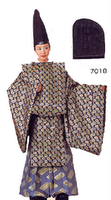
http://www.shop-japan.co.jp/english-boku/image-e/eboshi.gif
Golden Official Hat, kin eboshi
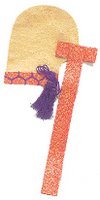
www.shop-japan.co.jp/shop/n-kaburikasa-s.htm
Photos of : eboshi
. eboshi 烏帽子 と伝説 Legends about ritual caps .
:::::::::::::::::::::::::::::::::::::::::::::::::::::::::::::::::::::::::::::::::::::::::::::::::::::
HAT .. kigo for all summer
Japanese ladies try to protect their faces from the summer sunshine, to stay as white as possible. The straw hat comes in a form rather like a cowboy hat.
summer hat, natsu booshi 夏帽子natsu boshi, mugiwara boshi
..... natsuboo 夏帽(なつぼう)
panamaboo パナマ帽(ぱなまぼう)Panama hat
kankanboo カンカン帽(かんかんぼう) Kankan hat
boater; a stiff straw hat (for men)
mugiwaraboo 麦稈帽(むぎわらぼう)straw hat
kyoogiboo 経木帽(きょうぎぼう)
hat made from a paper-thin sheet of wood
amigasa 編笠 (あみがさ) braided hat of straw [sedge/rush]
..... daigasa 台笠(だいがさ)
..... sugegasa 菅笠(すげがさ)
igasa 藺笠(いがさ)(made frow igusa straw)
takenokogasa 籜笠(たけのこがさ)(made from bamboo shoots)
Kumagaigasa 熊谷笠(くまがいがさ)(from the Kumagai area, Musashi no kuni)
manjuugasa 饅頭笠(まんじゅうがさ)
. . . CLICK here for Photos !
hinokigasa 檜笠(ひのきがさ)
ajirogasa 網代笠(あじろがさ)
see above
ichimegasa 市女笠(いちめがさ)hat for a traveling woman in the Heian period
. . . CLICK here for Photos !
onnagasa 女笠(おんながさ) hat for a woman
straw hat, wara booshi 藁帽子
wheat straw hat, mugiwara booshi 麦藁帽子
Cheap versions come from China these days and cost only about one dollar.
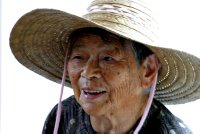
http://miken.jimjim.heavy.jp/?eid=146639#comments
"straw hat", warabooshi 藁帽子 , is also the name for the harvested rice heaped up in the fields to dry for a few days.
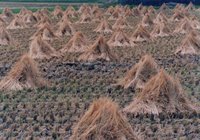
http://www.city.anjo.aichi.jp/kakuka/toshikei/anjo/siki/framesiki1.html
:::::::::::::::::::::::::::::::::::::::::::::::::::::::::::::::::::::::::::::::::::::::::::::::::::::::
hood, zukin 頭巾
topic for haiku
It was word by ninja and the firebrigade, to protect their head.
Here is one from the famous Hattori Hanzoo 服部半蔵.

http://www.craft.ne.jp/muromachi/kage01.html
. zukin 頭巾 (ずきん) hood .
kigo for winter
akazukin 赤頭巾 is the .. little red riding hood
.......................................................................

source : myacyouen-hitorigoto
- - - - - Matsuo Basho wrote
On a snowy night I playfully sought a dai hood, using the two words “buying rice” as my topic
米買ひに雪の袋や投頭巾
kome kai ni yuki no fukuro ya nagezukin
off to buy rice
with a snow covered bag—
my winter hood
A playful, pun-filled poem. Basho is without rice or a winter hood and converts his empty rice sack into a hood. Nagezukin, one of several types of head-pieces used to keep out winter’s wind and cold, had a long section draping down the back.
Dai was a type of hood, and also the word for “topic” for a poem.
Yuki here means both “to go (buy rice)” and “snow.”
Tr. and comment by Barnhil
Written on the 17th day of the 12th lunar month, 1688 元禄元年12月17日, Basho age 45.
Hokku for a kukai meeting with the Fukagawa happin 深川八貧 "Eight Beggars of Fukagawa".
nagezukin 投げ頭巾 "throw cap", is a cloth cap or hood or squared-off bonnet with a long piece of cloth to "throw" down the back.
It was often worn by the sweet vendors of Edo。
yuki is a pun with the pronounciation for snow or going 行き, in the Danrin style of hokku.
. Matsuo Basho 松尾芭蕉 - Archives of the WKD .
Fukagawa happin 深川八貧 "The Eight Poor of Fukagawa"
. 芭蕉庵 Basho-An in Fukagawa 深川 .
.......................................................................
ten takashi akaboo Jizoo no egao kana
天高し赤帽 地蔵の 笑顔かな

bright Autum sky -
Jizo with his red hood
smiling peacefully
More about Jizo Bosatsu, by Gabi Greve
:::::::::::::::::::::::::::::::::::::::::::::::::::::::::::::::::::::::::::::::::::::::::::::::::::::::
headband, bandana, hachimaki 鉢巻
topic for haiku

Daruma Doll with a Headband
The Shogun and other noble folk would wear a purple headband when they were ill. Even today, we can see this in Kabuki plays. Here is Ichikawa Ebizo as Sukeroku 助六.

www.nekoten.com/mt/archives/2004/06/index.php
*****************************
Worldwide use
USA
The Hat Museum at the Ladd-Reingold House, Oregon
http://www.thehatmuseum.com/
*****************************
Things found on the way
. Hats and caps with Daruma pattern .
*****************************
HAIKU
This is the haiku that started this whole discussion.
waga mono to omoeba karoshi kasa no yuki
Kikaku (1661-1707)
"My snow!"--when I think that,
it weighs almost nothing
on my umbrella-hat!
Henderson, "An Introduction to Haiku"
Click HERE to read more about SNOW on my HAT"
:::::::::::::::::::::::::::::::::::::::::::::::::::::::::::::::::::::::::::::::::::::::::::::::::::::
雨笠も日笠もあなた任せ哉
ama-gasa mo higasa mo anata makase kana
umbrella-hats
sun hats...
trust in Buddha!
旅笠を小さく見せる霞かな
tabi-gasa o chiisaku miseru kasumi kana

their traveling hats
looking small...
mist
Tr. Lanoue
Kobayashi Issa
Haiga by Nakamura Sakuo
わか草に笠投やりて入る湯哉
wakakusa ni kasa nageyarite iru yu kana

© Haiga by Nakamura Sakuo
http://sakuo3903.blogspot.com/
my umbrella-hat
left on the baby grass...
a hot bath
Tr. Lanoue
traveling hats
small in
the mist
Tr. Chris Drake
This hokku is from the New Year's anthology of the Katsushika school of haikai in Edo published at the beginning of 1796, so it must have been written in 1795, when Issa, 33, was traveling around in western Honshu and Shikoku. The wide, woven-rush hats belong to travelers (or a traveler) off in the mist, either coming toward Issa or disappearing into the mist.
The large hats are the most prominent parts of the travelers, who must be on the verge of slipping into or out of sight. Their hats, still partly visible, link the barely seen travelers to both the visible and invisible worlds. Japanese depictions of ghosts show them with no feet, and the feet of the travelers in this hokku must be invisible or nearly invisible, though they are not exactly ghosts. They are close enough to be individuals, but far enough away to be beyond the I-you relationship. Are they linked to Issa in his memory, or are they about to burst into his world?
Chris Drake
:::::::::::::::::::::::::::::::::::::::::::::::::::::::::::::::::::::::::::::::::::::::::::::::::::::
Kinkaishuu (金塊集) waka 348 by the third Minamoto shogun Sanetomo (1192-1219):
hail hits
hard on the gauntlet
of the warrior
arranging his arrows
in a wild field in Nasu
In the waka a high-ranking warrior, perhaps implied to be Sanetomo's father, the first Kamakura shogun Yoritomo, is hunting in some wild fields covered by low bamboo. Resting for a moment, the warrior sits on his horse with his bow in his right hand. With his left hand he reaches back and makes sure the arrows in his quiver are arranged correctly so they can be pulled out easily. On his left arm is a long gauntlet, a thick sleeve with mail and pieces of metal on the outside that covers the lower 2/3 of his arm as well as the back of his left hand, leaving only the tips of his fingers and his palm uncovered. This strong gauntlet protects his left arm from being hit by the bowstring, and in battle it would protect his left arm from an enemy. On the day of the hunt the hail bouncing off the gauntlet creates an image of strength and vitality, as if the warrior were ignoring the hail and gathering his energy as he prepares to ride off.
toonori ya arare tabashiru kasa no ue
Read about this haiku by Issa and a discussion and
. Comment by Chris Drake .
:::::::::::::::::::::::::::::::::::::::::::::::::::::::::::::::::::::::::::::::::::::::::::::::::::::
flower gathering
her straw hat accepts
the butterfly
- Shared by Sandi Pray -
Joys of Japan, 2012
*****************************
Related words
***** Haiku Translation Discussion:
Kasa no Yuki
:::::::::::::::::::::::::::::::::::::::::::::::::::::::::::::::::::::::::::::::::::::::::::::::::::::
.SAIJIKI ... HUMANITY
Kigo for Summer
:::::::::::::::::::::::::::::::::::::::::::::::::::::::::::::::::::::::::::::::::::::::::::::::::::::
. WKD : umbrella (kasa)
MORE
hokku about the traveller's hat by
. Matsuo Basho 松尾芭蕉 - Archives of the WKD .
[ . BACK to WORLDKIGO . TOP . ]
[ . BACK to DARUMA MUSEUM TOP . ]
:::::::::::::::::::::::::::::::::::::::::::::::::::::::::::::::::::::::::::::::::::::::::::::::::::::






19 comments:
Gabi san
This is important information on many thinks about hat.
thank you so much your helping me in haiku working.
sakuo.
evening cool--
my umbrella-hat left
at the last inn
yuusuzu ni kasa wasure keri ato no yado
夕涼に笠忘れけり後の宿
by Issa, 1821
Literally, the hat was left at the last "dwelling" (yado). I take this to mean an inn. The air was so wonderfully cool, Issa went out bareheaded, leaving his kasa behind.
Tr. David Lanoue
http://cat.xula.edu/issa/
so many cicadas
singing and tumbling off...
umbrella-hat
moro-zemi no naki kobore keri kasa no ue
.もろ蝉の鳴こぼれけり笠の上
by Issa, 1822
Tr. David Lanoue
http://cat.xula.edu/issa/
頭巾きた阿房阿房とや夕水鶏
zukin kita ahoo ahoo to ya yuu kuina
"You're a lot of fools
wearing skullcaps!"
evening moorhens
Kobayashi Issa
(tr. David Lanoue)
though in Buddha's presence
just a simple cloth
skullcap
go-butsuzen demo gomen zukin kana
.御仏前でも御めん頭巾哉
by Issa, 1823
(Tr. David Lanoue)
吉野にて桜見せうぞ檜木笠
Yoshino nite sakura mishoo zo hinoki-gasa
Here we are in Yoshino
so let us look at the cherry blossoms !
My pine-bark hat.
Matsuo Basho
In March of 1688. Basho with his student Tokoku 杜国.
笠もなきわれを時雨るるかこは何と
kasa mo naki / ware o shigururu ka / ko wa nanto
Matsuo Basho
木の葉散る桜は軽し檜木笠
このはちるさくらはかるしひのきがさ
konoha chiru sakura wa karushi hinokigasa
falling leaves
of the cherry tree so light
on my pilgrim's hat
Matsuo Basho
米買ひに雪の袋や投頭巾
kome kai ni / yuki no fukuro ya / nage zukin
Matsuo Basho
nagezukin 投頭巾
Matsuo Basho
幼名や知らぬ翁の丸頭巾
osana na ya shiranu okina no maruzukin
a name for a boy -
the round hood of an old man
I never met
Tr. Gabi Greve
(for Matsunaga Teitoku)
.
a maruzukin 丸頭巾 was used by elderly men.
Also called hooroku zukin 焙烙 頭巾 or Daikoku zukin 大黒頭巾
.
Discussing this hokku :
Yosa Buson
春雨や身にふる頭巾着たりけり
harusame ya mi ni furu zukin kitarikeri
.
spring rain
kyoogiboo, kyougibou 経木帽 kyokibo hat
hat made from a paper-thin sheet of wood
chip bonnet, wood-chip hat, chip-plait hat
存在の大きさ経木帽の大きさ
sonzai no ookisa kyoogiboo no ookisa
the largeness of existence
the largeness of this chip-plait hat
Kakurai Akio 加倉井秋を (1909 - 1988)
kago 籠 / 篭 / かご basket, baskets of all kinds
zaru ざる / 笊 bamboo baskets
sugezaiku, suge-zaiku, suge saiku 菅細工 / すげ細工
handicraft from sedge, reed weaving
Yatsubake zukin 八つ化け頭巾
The hood for eight spooks
a story about a priest and Fudo Myo-O!
.
.
Yosa Buson
折釘に烏帽子かけたり春の宿
orekugi ni eboshi kaketari haru no yado
On a bent hook
hangs an official's cap,
the lodging house in spring.
Tr. Yuki Sawa
.
More about the bent hook and other Japanese nails
http://edoflourishing.blogspot.jp/2015/01/kugikakushi.html
.
- eboshi -
A beautiful female devil named Tateeboshi 立烏帽子 Tate Eboshi was the wife of 鬼神 the Demon King 大竹丸 Odakemaru.
.
And more legends about this Lady Tate-Eboshi.
https://kappapedia.blogspot.jp/2017/09/odakemaru-and-tamuramaro-iwate.html
.
eboshi - 烏帽子
28 legends to explore
.
Nichibun Yokai database
.
rokubu-gasa 六部笠 special straw hat for a Rokubu pilgrim
rokujuurokubu 六十六部 Rokujurokubu, Rokujuroku Bu pilgrimage
sixty-six part circuit
六部(ろくぶ) Rokubu pilgrimage, Rokubu pilgrim
Pilgrim traveling 66 volumes of the Lotus Sutra
Rokujurokubu Hijiri - kaikoku hijiri 廻国聖 - itinerant Rokubu Pilgrim
六十六部行者 rokujuurokubu gyooja / 六部行者 / rokubu gyoja
六十六部廻国巡礼 rokujurokubu kaikoku junrei
.
https://gokurakuparadies.blogspot.jp/2017/10/rokujurokubu-rokubu-pilgrimage.html
.
Post a Comment